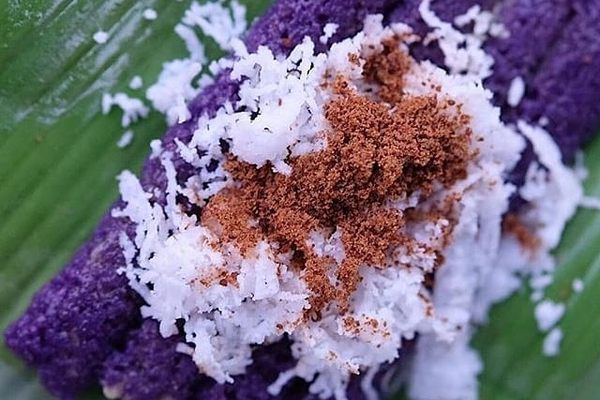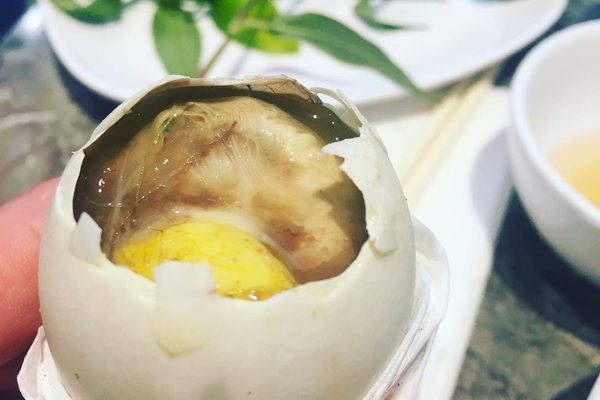Balut sa puti (“wrapped in white”) sounds like a cliché describing a bride on her wedding day. In actuality, it’s the Tagalog phrase that gives balut—a hard-boiled egg housing a duck embryo—its name.
Fertilized eggs are a late-night snack in the Philippines. When the sun sets, vendors roam neighborhoods or set up shop on the sidewalk, peddling warm eggs to the chant of “baluuuuuuut!” Workers and partiers alike turn to this protein-dense, cheap, salty snack for prime recovery fuel after a long night. Some say it’s a good aphrodisiac. Others would just rather not see what they’re eating; even those who love the taste often don’t linger on the developing duck and vein-lined yolk.
To eat balut, Filipinos start by cracking off the narrow end of the shell. They peel a small hole in the membrane and sip the amniotic fluid, a warm, gamey liquid marketed as “soup.” Next, they season the egg with salt and vinegar, then peel and eat the bulbous yolk and delicate bird inside.
Older eggs contain more pronounced ducklings, with palpable bones and beaks. They also yield a tougher egg white, called bato (“stone”). Most people discard this portion, likening the texture to a rubber eraser. The younger the egg, the more tender its contents—which some fans opt to shoot back like a raw oyster. A less mature (and less popular) form of balut is known as mamatong (roughly, “the float”). In these eggs, the embryo floats on top of the white and the yolk.
Sellers choose their balut’s stage of development by purchasing duck eggs on the day they’re laid. They then incubate them for two to three weeks. After boiling the eggs, the vendors sell the hot and fresh baby ducks to help replenish depleted night owls.
Where to Try It
-
Sta. Martha's Balut Industry
953 P. Herrera, Pateros, PhilippinesReviewers highly recommend the balut here from a vendor named "Mr. Jessie."
-
This Filipino restaurant in New York's East Village offers many national specialties, including balut, pork adobo, and sisig.
Written By
 rachelrummel
rachelrummel
Sources
- thetakeout.com/balut-the-terrifying-hard-boiled-duck-fetus-that-s-als-1798253710
- eatyourworld.com/destinations/asia/philippines/manila/what_to_eat/balut
- www.businessinsider.com/balut-egg-duck-fetus-eat-it-2015-1
- medium.com/the-mission/what-eating-an-actual-duck-fetus-taught-me-about-life-dd867b9229c1
- www.cnn.com/travel/article/how-to-eat-balut/index.html
- cityroom.blogs.nytimes.com/2012/08/23/sampling-a-filipino-dish-theyll-be-competing-to-gulp-down/?mtrref=www.theatlantic.com&gwh=B2EC4A0F1EA20E1D859542497742F98D&gwt=pay
- books.google.com/books?id=cfP6jHmSLnMC&pg=PT169&lpg=PT169&dq=balut+oxford+eggs&source=bl&ots=NTsb-983mA&sig=TEzbqotlvpbQddauvSo06P9XXc0&hl=en&sa=X&ved=0ahUKEwjcl-Ln_OzYAhVJSt8KHZj7APQQ6AEIYjAO#v=snippet&q=older&f=false
- palengkequeen.blogspot.com/2012/01/where-to-buy-balut-in-pateros-of-course.html















